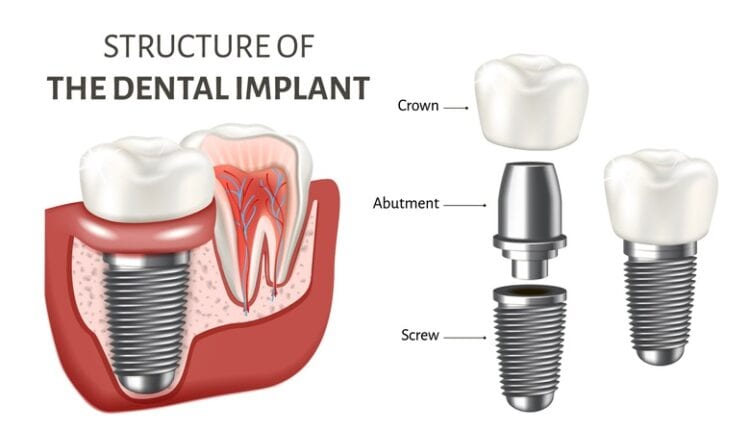One of the most exciting innovations to enter dentistry in the last 30 years is implant dentistry. A patient has the ability to replace missing teeth with a simple in-office surgery to place a titanium anchor. After the implant has healed, a crown is placed over the implant, restoring a patient’s teeth and smile. While an advanced procedure, implants have a high success rate and are important for overall oral health. Implants can also be used to replace multiple teeth or to anchor a denture.
- Single tooth replacement
- Full mouth replacement
- Denture anchoring
Before and After Dental Implants

Why Should I Replace Missing Teeth?
When you lose a tooth, the best thing for your oral health is to have that tooth replaced. A tooth that is missing can affect your “bite”, your ability to speak, eat, and chew. It can also cause an increased burden on your remaining teeth resulting in muscle pains in your jaw as well as headaches. One of the ways that dentists can replace a missing tooth is by the use of dental implants.
What Is A Dental Implant?
In order to describe what a dental implant is, lets take a look at what a real tooth consists of. A real tooth has roots and a crown. The crown is the chewing surface of the tooth. The root is beneath the crown and anchors the tooth through the gum tissue to the jawbone. Losing a tooth is a loss of both the crown and the root. In order to replace a tooth, dentists have to create a new root via a dental implant.
The dental implant, which is a titanium root, is fitted to a socket that is created in a patient’s jaw. Once the implant has been created in the jaw, the bone around the implant needs to heal for up to six months. This is the initial stage of healing and at the end of this time period, a support post called an abutment is placed on the implant and then a new crown will be placed on top.
When Are Implants Placed?
An implant is inserted at the same location as the missing tooth. If your tooth was removed by a dentist, due to excessive tooth decay (cavities), infection or cancer, a dental implant is installed three months after a tooth extraction.
During these three months, the socket walls of jawbone that housed your teeth, will grow new bone to replace or refill the empty socket. Typically, the socket is completely filled with bone by your followup appointment to replace with an implant. This provides an ideal platform for a dental implant to be securely and permanently installed.
If your tooth has been missing for a long time, the bone that is adjacent to the socket will grow thinner because the stimulation that is created by the tooth root is no longer present. As much as one third of your jaw’s thickness can be lost in the year following the loss of a tooth.
Too much bone loss could require an additional bone grafting procedure before implant surgery. This is sometimes required for patients and provides a solid base for an implant to be supported adequately.
How Many Implants Do I Need?
Typically, one dental implant is needed per missing tooth. This rule does not apply, however, to the back teeth. The back teeth have two or three roots. The approach that is most commonly used is to replace back teeth with larger implants or more than one implant per tooth. Using more implants per tooth is a better option for patients with moderate bone loss or if there is excessive biting force on the back teeth.
Some treatment systems rely on 4 to 6 implants for an entire upper or lower jaw. Your dentist will discuss options including costs, timeline for the procedure and recovery expectations.
Is Dental Implant Surgery Painful?
Dental implant placement is a routine surgery performed at Hancock and Johnston Dentistry. Patients that undergo this procedure are given a local anesthetic that fully numbs the mouth before any drilling begins. Most patients are fully awake during the 1 hour surgery. Patients with multiple implants needed can take longer, closer to 2 – 3 hours.
For patients with dental anxiety, we can provide an oral sedative to allow you to sleep from beginning to end. You may experience some discomfort after the procedure, that can be handled by an over the counter pain killer. Most patients experience more pain during tooth extraction than implant surgery.
Dental Implant Surgery
 Although many treatments such as root canals to crowns are available in modern dentistry to prevent tooth extraction, it is still necessary. In some scenarios, the best outcome for a patient is removal of the teeth by a dentist. If your teeth were lost overtime or due to an emergency injury (car accident, sports, etc) or gum disease, dental implants are one of the few options available to restore your smile.
Although many treatments such as root canals to crowns are available in modern dentistry to prevent tooth extraction, it is still necessary. In some scenarios, the best outcome for a patient is removal of the teeth by a dentist. If your teeth were lost overtime or due to an emergency injury (car accident, sports, etc) or gum disease, dental implants are one of the few options available to restore your smile.
Hancock and Johnston Dentistry is southwest Lubbock is a leader in modern dentistry since 1975. Our practice has long provided dental implant surgery to patients of all ages, restoring smiles, confidence and oral health.
